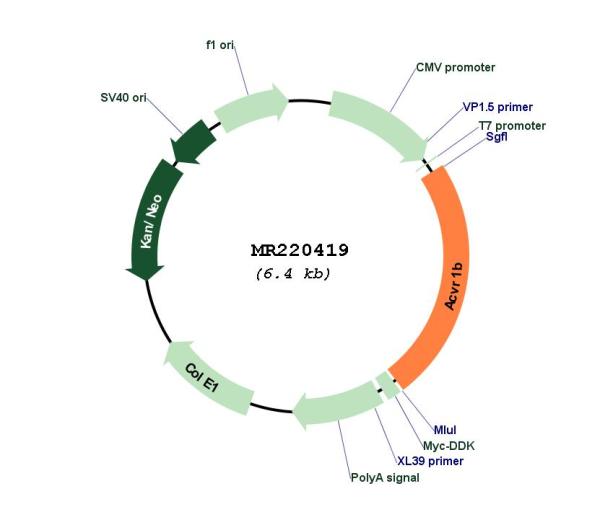Acvr1b (NM_007395) Mouse Tagged ORF Clone
CAT#: MR220419
- TrueORF®
Acvr1b (Myc-DDK-tagged) - Mouse activin A receptor, type 1B (Acvr1b)
ORF Plasmid: tGFP
Lentiviral Particles: DDK w/ Puro mGFP w/ Puro
AAV Particle: DDK
"NM_007395" in other vectors (4)
Interest in protein/lysate? Submit request here!
USD 198.00
Specifications
| Product Data | |
| Type | Mouse Tagged ORF Clone |
| Tag | Myc-DDK |
| Symbol | Acvr1b |
| Synonyms | 6820432J04; ActR-IB; ActRIB; Acvrlk4; Alk4; SKR2 |
| Vector | pCMV6-Entry |
| E. coli Selection | Kanamycin (25 ug/mL) |
| Mammalian Cell Selection | Neomycin |
| Sequence Data |
>MR220419 ORF sequence
Red=Cloning site Blue=ORF Green=Tags(s) TTTTGTAATACGACTCACTATAGGGCGGCCGGGAATTCGTCGACTGGATCCGGTACCGAGGAGATCTGCC GCCGCGATCGCC ATGGCGGAGTCGGCCGGAGCCTCCTCCTTCTTCCCCCTTGTTGTCCTCCTGCTCGCCGGCAGCGGCGGGT CCGGGCCCCGGGGGATCCAGGCTCTGCTGTGTGCGTGCACCAGCTGCCTACAGACCAACTACACCTGTGA GACAGATGGGGCTTGCATGGTCTCCATCTTTAACCTGGATGGCGTGGAGCACCATGTACGTACCTGCATC CCCAAGGTGGAGCTGGTTCCTGCTGGAAAGCCCTTCTACTGCCTGAGTTCAGAGGATCTGCGCAACACAC ACTGCTGCTATATTGACTTCTGCAACAAGATTGACCTCAGGGTCCCCAGCGGACACCTCAAGGAGCCTGC GCACCCCTCCATGTGGGGCCCTGTGGAGCTGGTCGGCATCATCGCCGGCCCCGTCTTCCTCCTCTTCCTT ATCATTATCATCGTCTTCCTGGTCATCAACTATCACCAGCGTGTCTACCATAACCGCCAGAGGTTGGACA TGGAGGACCCCTCTTGCGAGATGTGTCTCTCCAAAGACAAGACGCTCCAGGATCTCGTCTACGACCTCTC CACGTCAGGGTCTGGCTCAGGGTTACCCCTTTTTGTCCAGCGCACAGTGGCCCGAACCATTGTTTTACAA GAGATTATCGGCAAGGGCCGGTTCGGGGAAGTATGGCGTGGTCGCTGGAGGGGTGGTGACGTGGCTGTGA AAATCTTCTCTTCTCGTGAAGAACGGTCTTGGTTCCGTGAAGCAGAGATCTACCAGACCGTCATGCTGCG CCATGAAAACATCCTTGGCTTTATTGCTGCTGACAATAAAGATAATGGCACCTGGACCCAGCTGTGGCTT GTCTCTGACTATCACGAGCATGGCTCACTGTTTGATTATCTGAACCGCTACACAGTGACCATTGAGGGAA TGATTAAGCTAGCCTTGTCTGCAGCCAGTGGTTTGGCACACCTGCATATGGAGATTGTGGGCACTCAAGG GAAGCCGGGAATTGCTCATCGAGACTTGAAGTCAAAGAACATCCTGGTGAAAAAAAATGGCATGTGTGCC ATTGCAGACCTGGGCCTGGCTGTCCGTCATGATGCGGTCACTGACACCATAGACATTGCTCCAAATCAGA GGGTGGGGACCAAACGATACATGGCTCCTGAAGTCCTTGACGAGACAATCAACATGAAGCACTTTGACTC CTTCAAATGTGCCGACATCTATGCCCTCGGGCTTGTCTACTGGGAGATTGCACGAAGATGCAATTCTGGA GGAGTCCATGAAGACTATCAACTGCCGTATTACGACTTAGTGCCCTCCGACCCTTCCATTGAGGAGATGC GAAAGGTTGTATGTGACCAGAAGCTACGGCCCAATGTCCCCAACTGGTGGCAGAGTTATGAGGCCTTGCG AGTGATGGGAAAGATGATGCGGGAGTGCTGGTACGCCAATGGTGCTGCCCGTCTGACAGCTCTGCGCATC AAGAAGACTCTGTCCCAGCTAAGCGTGCAGGAAGATGTGAAGATT ACGCGTACGCGGCCGCTCGAGCAGAAACTCATCTCAGAAGAGGATCTGGCAGCAAATGATATCCTGGATT ACAAGGATGACGACGATAAGGTTTAA >MR220419 protein sequence
Red=Cloning site Green=Tags(s) MAESAGASSFFPLVVLLLAGSGGSGPRGIQALLCACTSCLQTNYTCETDGACMVSIFNLDGVEHHVRTCI PKVELVPAGKPFYCLSSEDLRNTHCCYIDFCNKIDLRVPSGHLKEPAHPSMWGPVELVGIIAGPVFLLFL IIIIVFLVINYHQRVYHNRQRLDMEDPSCEMCLSKDKTLQDLVYDLSTSGSGSGLPLFVQRTVARTIVLQ EIIGKGRFGEVWRGRWRGGDVAVKIFSSREERSWFREAEIYQTVMLRHENILGFIAADNKDNGTWTQLWL VSDYHEHGSLFDYLNRYTVTIEGMIKLALSAASGLAHLHMEIVGTQGKPGIAHRDLKSKNILVKKNGMCA IADLGLAVRHDAVTDTIDIAPNQRVGTKRYMAPEVLDETINMKHFDSFKCADIYALGLVYWEIARRCNSG GVHEDYQLPYYDLVPSDPSIEEMRKVVCDQKLRPNVPNWWQSYEALRVMGKMMRECWYANGAARLTALRI KKTLSQLSVQEDVKI TRTRPLEQKLISEEDLAANDILDYKDDDDKV |
| Restriction Sites |
SgfI-MluI
Cloning Scheme for this gene
Plasmid Map

|
| ACCN | NM_007395 |
| ORF Size | 1518 bp |
| OTI Disclaimer | The molecular sequence of this clone aligns with the gene accession number as a point of reference only. However, individual transcript sequences of the same gene can differ through naturally occurring variations (e.g. polymorphisms), each with its own valid existence. This clone is substantially in agreement with the reference, but a complete review of all prevailing variants is recommended prior to use. More info |
| OTI Annotation | This clone was engineered to express the complete ORF with an expression tag. Expression varies depending on the nature of the gene. |
| Product Components | The ORF clone is ion-exchange column purified and shipped in a 2D barcoded Matrix tube containing 10ug of transfection-ready, dried plasmid DNA (reconstitute with 100 ul of water). |
| Reconstitution | 1. Centrifuge at 5,000xg for 5min. 2. Carefully open the tube and add 100ul of sterile water to dissolve the DNA. 3. Close the tube and incubate for 10 minutes at room temperature. 4. Briefly vortex the tube and then do a quick spin (less than 5000xg) to concentrate the liquid at the bottom. 5. Store the suspended plasmid at -20°C. The DNA is stable for at least one year from date of shipping when stored at -20°C. |
| Reference Data | |
| RefSeq | NM_007395.4 |
| RefSeq Size | 3277 bp |
| RefSeq ORF | 1518 bp |
| Locus ID | 11479 |
| UniProt ID | Q61271 |
| Cytogenetics | 15 56.48 cM |
| MW | 56.7 kDa |
| Gene Summary | Transmembrane serine/threonine kinase activin type-1 receptor forming an activin receptor complex with activin receptor type-2 (ACVR2A or ACVR2B). Transduces the activin signal from the cell surface to the cytoplasm and is thus regulating a many physiological and pathological processes including neuronal differentiation and neuronal survival, hair follicle development and cycling, FSH production by the pituitary gland, wound healing, extracellular matrix production, immunosuppression and carcinogenesis. Activin is also thought to have a paracrine or autocrine role in follicular development in the ovary. Within the receptor complex, type-2 receptors (ACVR2A and/or ACVR2B) act as a primary activin receptors whereas the type-1 receptors like ACVR1B act as downstream transducers of activin signals. Activin binds to type-2 receptor at the plasma membrane and activates its serine-threonine kinase. The activated receptor type-2 then phosphorylates and activates the type-1 receptor such as ACVR1B. Once activated, the type-1 receptor binds and phosphorylates the SMAD proteins SMAD2 and SMAD3, on serine residues of the C-terminal tail. Soon after their association with the activin receptor and subsequent phosphorylation, SMAD2 and SMAD3 are released into the cytoplasm where they interact with the common partner SMAD4. This SMAD complex translocates into the nucleus where it mediates activin-induced transcription. Inhibitory SMAD7, which is recruited to ACVR1B through FKBP1A, can prevent the association of SMAD2 and SMAD3 with the activin receptor complex, thereby blocking the activin signal. Activin signal transduction is also antagonized by the binding to the receptor of inhibin-B via the IGSF1 inhibin coreceptor. ACVR1B also phosphorylates TDP2.[UniProtKB/Swiss-Prot Function] |
Documents
| Product Manuals |
| FAQs |
| SDS |
Resources
Other Versions
| SKU | Description | Size | Price |
|---|---|---|---|
| MC217130 | Acvr1b (untagged) - Mouse activin A receptor, type 1B (Acvr1b), (10ug) |
USD 518.00 |
|
| MG220419 | Acvr1b (tGFP-tagged) - Mouse activin A receptor type 1B (Acvr1b), (10ug) |
USD 671.00 |
|
| MR220419L3 | Lenti ORF clone of Acvr1b (Myc-DDK-tagged) - Mouse activin A receptor, type 1B (Acvr1b) |
USD 771.00 |
|
| MR220419L4 | Lenti ORF clone of Acvr1b (mGFP-tagged) - Mouse activin A receptor, type 1B (Acvr1b) |
USD 771.00 |
{0} Product Review(s)
Be the first one to submit a review






























































































































































































































































 Germany
Germany
 Japan
Japan
 United Kingdom
United Kingdom
 China
China


